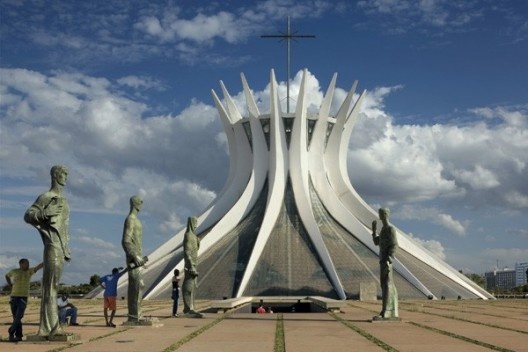
Catedral, Brasília. Arquitecto Oscar Niemeyer, 1958-1960
FC: That trip to Porto Alegre led you to visit Brasilia for the first time.
DM: Yes, I have been wishing to go to Brazil for many years. I always said that I did not want to die without seeing Rio de Janeiro. Rio sketches made by Le Corbusier impressed me a lot when I was a student and I think that they got etched in my subconscious. It was something I wanted to see in reality: I needed to have my own first-hand experience of this unique city made of skyscrapers and shacks, sitting in the midst of queer mountains, surrounded by fabulous beaches and inhabited by dream girls... After all the waiting and dreaming about it my expectations were huge and, like it always happens in such cases, I ended up somehow disappointed with the reality. The city is so immense that all these topographic details could hardly be perceived all together, so their impact on me turn out to be somehow diluted. Another thing that produced a negative impression was this feeling of insecurity and a permanent state of alert that you can notice in the eyes of the people in the streets…
Anyway, as an architect I also was keen on going to Brasilia.
FC: Before we talk about you trip to Brazil… During your student days, Brasilia was sharply criticized in Italy, wasn’t it?
DM: In college we did not dedicate time to study Brasilia since, from an Italian point of view, focused on the preservation of historic patrimony, a newly established capital city represents something very exotic. A Canberra-style capital or Dhaka, cities that I still haven't visited, are studied only superficially, as part of the cultural baggage that any architect must possess...
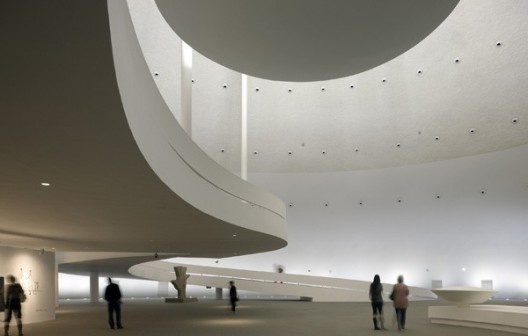
Museu Nacional Honestino Guimarães, Brasília. Arquitecto Oscar Niemeyer, 2009
FD: What impressed you in that city in the first moment of your arrival?
DM: Many things. Even before arriving the first thing that struck me was the address of the hotel: "Hotel Sector West"! It seemed amazing ... I wondered, "and when you leave the Hotel Sector, where are you? At the Health Sector? Schools sector?" This scheme was so unfamiliar to me that it increased my curiosity. After arriving in Brasilia I was shocked with the size of the city. It was next to impossible to get from one place to another on foot. Somewhat surprising but in the negative sense. I could not believe that designers who are among the great geniuses of urbanism have not noticed how unpleasant it is when it takes one a quarter of an hour to cross a street... In short, I was impressed with the monumentality of certain areas and buildings, but also their lack of pragmatism. There is a big difference between seeing places in pictures and living an experience, with the sun, heat and knowing what it is like when your feet hurt from going from one site to another. For example, the distance between the Cathedral and the Three Powers Square is unimaginable even though in theory they are adjacent.
FC: Your photos clearly show that: there is not only architecture, buildings, but also those immense empty spaces.
DM: This is exactly what I was looking for during that first contact which was very superficial on the other hand. I'm happy with the result but I wish I had a chance to return and do more, staying longer. As I said, for me photography is also a means of getting to know things. I went to get to know Brasilia rather than just to take photos, but in that case taking photos helped me to understand. Two visions merged together in that reportage: on the one hand, my "recognition” of famous buildings, which somehow I already knew, and on the other hand, the discovery of vast spaces, of newly completed buildings, also of old buildings by unknown architects ... things that nobody had told me about. So, as I pointed out, I tried to talk about things I knew that existed along with others whose existence I didn’t even suspect.
FC: How did you find your way around the city and identify the projects? With a guide?
DM: In a rather superficial, even venturesome way since I didn't want to deprive myself of surprises... I primarily used a tourist map with icons that indicated the places that for some reason were considered important. It was well-presented and helped me to identify the areas where something interesting happened... However, I neglected the embassies area as they were not indicated on the map and my time was limited anyway. I discovered it before leaving but I didn’t have a chance to take photos because there was always the problem of accessing the embassies. So, ignoring the difficulties that I could face there, I focused on more achievable things.
FC: If you had an opportunity to go back to Brasilia today, what do you think you would change in your vision when taking new photos?
DM: O course, I would have a very different vision because it would be no longer an unknown territory for me. Logically, it would be an opportunity to fill in the gaps, as I mentioned, the embassies or the Palace of the Alvorada or the interior of the Ministry of Foreign Affairs... In short, I would like to visit many things that require advance planning and scheduling.
FC: And finally, does Duccio Malagamba, a traveler that goes around with a small camera case, get to enjoy these trips?
DM: Unfortunately, he doesn’t. It feels bad to admit that I don’t enjoy it anymore. At the beginning one of the things that attracted me in photography was the excuse to travel. In fact, before joining the faculty of architecture, I paid my trips by selling my photos to travel magazines. But at some point in my life I lost the ability to savor my journeys, and it’s not because I don’t like travelling but because now I am unable to reduce the time I dedicate to their main purpose of the trip. I’ve got so self-demanding that I fail to interrupt my work and focus on something else. Before, indeed, I had time to relax and go to bars, restaurants, visits out of the schedule, even met people, but this capacity has progressively diminished and is now at its minimum. On the other hand, I travel very little if it’s not for work. During holidays, for example, I always go to the same place. Brazil was a happy exception because I had such a strong wish to visit the city that I took one week off exclusively for that. In fact in Rio I left the camera in the hotel in order to forget my job and did not take a single photograph. Unlike Rio, I approached my trip to Brasilia, like I told you, in a different way...
(Read an article in Architectural Review with text and photographies by Duccio Malagamba)
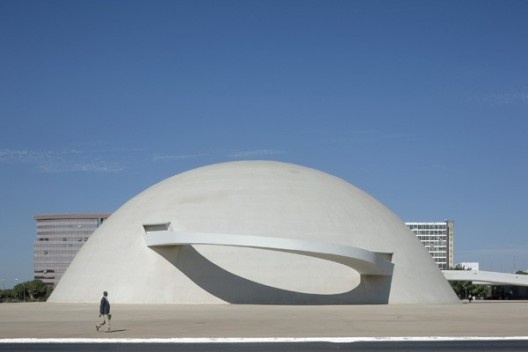
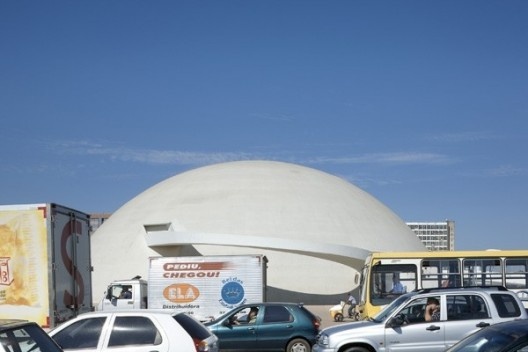
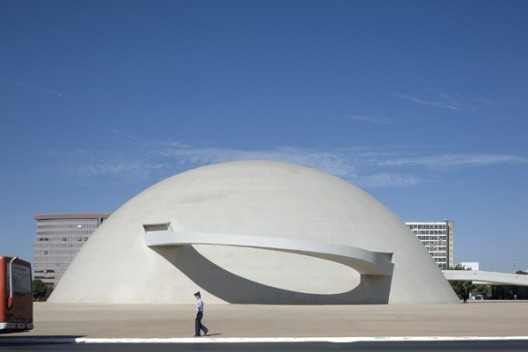
Museu Nacional Honestino Guimarães, Brasília. Arquitecto Oscar Niemeyer, 2009



